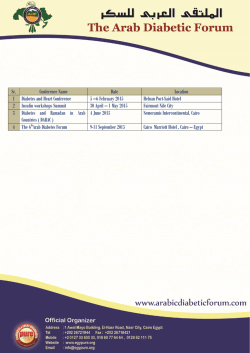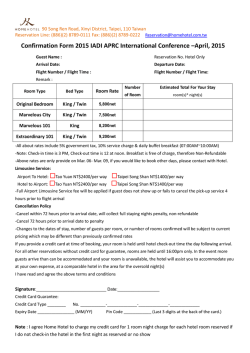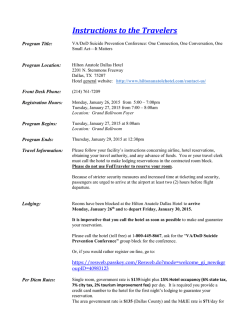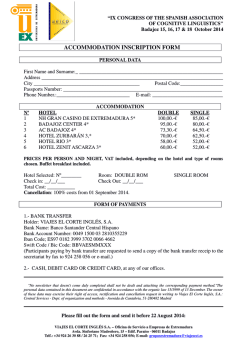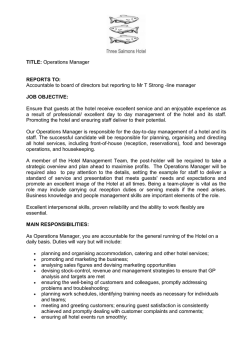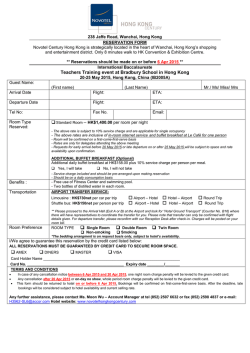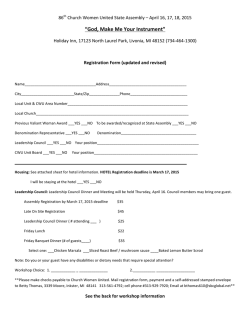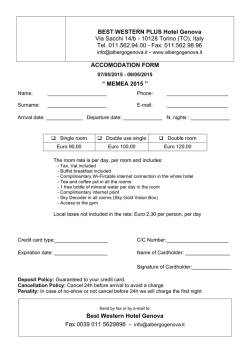
Q1 2015 - MEC Global
Q1 2015 Click to skip to section MEC Idea of the Quarter Welcome back to the latest edition of Stuff We’ve Seen. Once again, we’ve got a great mix of brilliant campaigns, superb creative use of technology, some exciting startups and the latest news from the world of media, technology and communications. As ever, we welcome feedback and input from around the network. Any great work you come across, please send it our way. And similarly, don’t be shy in submitting the great work we’re doing for our clients to be showcased – big or small ideas, all are welcome. Hope you enjoy! Idea of the Quarter Integrated Campaigns & Smart Ideas Creative use of Technology Interesting Start-ups & Emerging Tech Use the arrows on each page to view more inspiring detail 2 Marriott seeks out a new IKEA storytelling ‘Medium’ 3 Marriott partnered with Medium to launch a new native advertising platform In a world of short-form content, many people seek out platforms that allow them to share and find stories that tap into longer or more visual formats. Medium, the blog publishing platform founded by Twitter co-founders Evan Williams and Biz Stone, offers the ability to tap into true, powerful storytelling. In an attempt to connect with next-generation travelers and drive new business, Marriott International partnered with Medium to launch Gone, a new travel vertical blending native advertising with paid sponsorship. Among the 60 stories that will be published on Gone and labeled “presented by Marriott,” a select few will be loosely connected to Marriott and identified as being published by Marriott. It is a powerful example that, in a world where many messages are 140 characters (or less), powerful, meaningful stories will attract people no matter the format or length. Dole creates the first edible wearable Dole gives runners a boost by turning a mid-race snack into a tech-driven tool Dole Japan, a longtime sponsor of the Tokyo Marathon, created a wearable banana for the most recent race. Thanks to an LED display and sensors inserted under the bananas' skin, runners who grabbed a banana along the route were able to monitor their race time and heart rate. The smart banana even drove Twitter messages of encouragement for the runners. Once runners crossed the finish line, the bananas were enjoyed as a post-race treat. This is a quirky example of leveraging technology to make things smarter by serving multiple purposes. While not everyone may be interested in smart food, this is a fun way to provide runners with utility on the go. INTEGRATED CAMPAIGNS & SMART IDEAS 7 IKEA displayed poorly assembled billboards to show the importance of their Assembly Service IKEA is known for leveraging eye-catching OOH billboards to make the most out of simple ideas, and their Assembly Fail campaign is no exception. A lot of people joke about how IKEA furniture is difficult to put together, so much so that misassembled furniture has become a running gag. To promote their Assembly Service, IKEA created (what looked like) poorly assembled billboards. It is a simple idea that shows their awareness of the perception that their furniture is hard to assemble, as well as their ability to take the feedback in stride and have a sense of humor about it. The campaign also showcases the easy solution of utilizing IKEA’s Assembly Service to help a customer out. 8 Women’s Aid uses digital billboards to promote its core message of the more people who notice, the less physical abuse occurs To coincide with International Women’s Day, a digital billboard was created to show the impact of domestic violence. What made the billboard unique was that the more people who looked at the billboard, the more the bruises and marks on the woman’s face started to disappear, demonstrating the idea of not “turning a blind eye” to the issue. If people want domestic violence to disappear faster, more people have to pay attention to the signs and make a difference. It is a powerful message brought to life thanks to facial recognition software that registered when people looked at the image. Snickers’ unique approach to traditional billboards creates buzz around its Super Bowl ad To promote their Super Bowl commercial, Snickers created a hilarious billboard that slowly transformed Marcia Brady into Danny Trejo. Thanks to a group of painters, the billboard was slowly transformed over a span of a few weeks. Not only was this billboard hype for Snickers’ Super Bowl ad, it also kicked off a promotion that encouraged people to show off who they were when they were hungry. The billboard was a unique and fun approach to out-of-home advertising. It created buzz and furthered interest in the upcoming Super Bowl ad. 10 10 Destination Unknown is a game leveraging real-time social content Schiphol Amsterdam Airport created Destination Unknown, a game that used real-time Instagram content to get users interested in learning more about Schiphol’s network. Users had a set amount of time to guess as many destinations as possible. The top 50 players with the highest scores had the chance to win two return tickets to any destination that can be reached via Schiphol Airport. Tapping into real, user generated content provided a way to increase awareness among potential travelers of Schiphol’s offerings in a way that felt relevant. Consumers who shared content via platforms like Instagram could discover new users, be inspired by other users’ content, and perhaps even find a new destination. CREATIVE USE OF TECHNOLOGY Google and Mattel bring back the classic View-Master, introducing Virtual Reality experiences for just $30 The classic View-Master toy is being re-launched as a partnership between Mattel and Google, allowing users to enjoy augmented reality and 3D experiences from the $30 device. Users can place their smartphones into the device to use the accompanying application to see 3D images or larger 3D environments. The View-Master uses Google’s Cardboard technology, which creates virtual reality out of simple materials such as paper and tape. 13 13 Additional experience reel packs will be made available to provide additional content, resulting in immersive digital experiences for children of all ages. Japan’s Henn-na Hotel will be staffed with humanoid robots This coming July we will see the launch of the Henn-na Hotel (meaning ”Evolve Hotel”) in Nagasaki, Japan. This hotel is truly unique, as the property will include 10 humanoid robots as a part of the hotel’s staff. The robots will be tasked with everything from carrying luggage to greeting guests to even cleaning hotel rooms. The Henn-na Hotel’s robots will be modeled on young Japanese women, and will mimic natural mannerisms including blinking and breathing. They will also be multilingual, fluent in Japanese, Chinese, Korean, and English. The goal of including these humanoid robots as part of the hotel staff is to enhance the hotel’s tech-focused hospitality offering, which includes facial recognition technology for room entry and a radiation panel to monitor body heat when establishing room temperatures. 14 McDonald’s promotes the Egg McMuffin using a digital billboard that rises along with the sun For many commuters, deciding what to have for (and where to get) breakfast in the morning can be a difficult task. In Canada, McDonald’s helps make the process a bit easier by using an eye-catching innovative billboard unit. Synced to the timing of the sun rising, McDonald’s billboard also rises, gradually revealing the image of an Egg McMuffin breakfast sandwich. This billboard demonstrates how out-of-the-box thinking in out of home executions can still create impact for consumers. 15 15 Thanks to IKEA, furniture can now multitask IKEA is partnering with Qi, a leader in wireless charging, to design and deliver a line of desks, lamps, and tables outfitted with integrated charging pads. The catch? The initial products only work with a handful of Android devices, though adaptors are available for iOS. IKEA’s charging furniture is expected to go on sale in Europe and North America in mid-April, and a global rollout is rumored to be in the works for later in the year. This innovation in furniture design helps bring consumers one step closer to a connected home, proving technology can help even the most basic everyday objects become smarter and help drive the future of the ‘connected home’. 16 Merrell uses virtual reality to connect with adventure seekers In an effort to reinvigorate their brand image among adventure seeking consumers, outdoor brand Merrell partnered with Oculus Rift to provide an interactive virtual reality experience. The first ever commercial in-motion Oculus Rift experience, users could walk around Merrell’s virtual reality landscape, and were tasked with completing a simulated hiking trail which included physical elements (e.g. a rock wall and rope bridge). By creating a virtual reality experience that incorporated the physical need to walk around, Merrell demonstrated that engaging consumer experiences can be effective in transforming brand perception. 17 Dutch airline KLM lets potential travelers give high fives for a trip to Amsterdam Live High Five, installed by Dutch airline KLM, gave people in New York City and Amsterdam the opportunity to win a trip across the Atlantic. Using an interactive unit featuring real time HD audio and video, individuals were encouraged to time the perfect high five for a chance at a free flight to the other city (depending on current location). Promoting KLM’s World Deal Weeks, this was a great example of how an airline can help connect people around the globe faster than ever before. Never Alone leverages the power of gaming to teach people about other cultures Never Alone is an interactive puzzle-based video game that taps into the lore of the Iñupiat people to tell stories of Alaska Natives. Built in partnership with the Alaska Native community, the game’s puzzles are based on Alaskan indigenous stories. Created in conjunction with the Cook Inlet Tribal Council, a non-profit organization that works with indigenous groups living in Alaska's urban areas, Never Alone proves that gaming doesn’t have to be boring to be educational or inspiring, and that, conversely, education can be an immersive experience. Smartwatch apps start to show real promise, delivering utility, diversion and, thanks to Domino’s, pizza Smartwatch apps are an ongoing debate as more devices filter into the mass market and brands increasingly test engagement opportunities. Some believe that consumers won’t use apps on such a small screen, while others think that most smartwatch apps will be used by consumers primarily to deliver data to some other device or interface. 20 Domino’s is testing the waters of branded smartwatch app utility by enabling customers to place and track their order via the Pebble and Android Wear. Branded tests like Domino’s will not only uncover brand-driven options for smartwatch devices, but also help consumers understand the utility these devices can potentially deliver. Shared_Studios leverages technology (new and old) to help develop international relations Shared_Studios is a design and technology-driven collective focused on using tech and physical spaces to create ‘wormholes’ between different parts of the world. The goal? Carving out secure spaces between different populations, allowing them to interact in ways never before imagined. Their latest project allows people to talk to strangers in different countries via portals built inside shipping containers with immersive audio and video technology. Translation is available to those who need it, allowing participants to have full-body, faceto-face conversations with strangers. For example, New Yorkers can engage with residents in Tehran to meet and learn more about each other. Ideally, the portal locations change on an ongoing basis. 21 Take control of everyday life thanks to the Misfit Flash The Misfit Flash allows users to control different aspects of everyday life (e.g. changing the household temperature, switching music choices, connecting with friends) all from their wrist. Thanks to its developer’s toolkit, thirdparty developers are able to integrate Misfit’s tracking functionality into their products and services. As a result, Misfit Flash connects with Nest, Spotify, IFTTT, Logitech Harmony and more to ensure connectivity via almost any platform. This allows users to move one step closer towards truly connected living, starting within their homes and spreading into everyday tasks and activities. 22 INTERESTING START-UPS & EMERGIN TECH Prynt proves analogue is the new digital by turning a smartphone camera into a Polaroid When a digital medium comes along and replaces a traditional one, the predecessor tends to acquire a nostalgic value for consumers – think of how vinyl became treasured and curated by audiophiles in the face of CDs and, later, MP3s and music streaming. Prynt is a perfect example of this tendency to idealize the old in the face of the new. It’s an app and an accompanying smartphone case that work together to turn digital snapshots into Polaroid-esque prints. 24 24 Funded in record time on Kickstarter (over $1.5m was raised), Prynt launched in March 2015. AirDog allows users to capture aerial shots using a GoPro Looking to get more from your GoPro videos? AirDog could be just what you need. AirDog is a drone for GoPro, allowing GoPro users to capture aerial videos of themselves in action. Users can launch the drone from a control panel on their wrist, and the drone will follow them while they perform their activities of choice, including adventure and water sports. The video is captured on the GoPro camera which can be mounted to the front of the AirDog drone. This is another example of drone technology looking for ways to provide value off of the battlefield and in consumers’ everyday lives. When crowdsourcing meets apps, miracles like Be My Eyes happens Technology allows for everyday miracles to happen, both major and minor. Be My Eyes is one of those miracles: an iPhone app that allows blind people to connect with a network of sighted people who can provide help with live video chat. How does it work? Be My Eyes connects volunteers around the world with blind users to help them virtually see the physical world. The app itself is wonderfully simple in design – the blind user connects to ask for help with anything from reading directions on a package to navigating an unfamiliar space. A live video feed enables the sighted person on the other end to see what the blind user cannot, and provide step by step instructions and information. It’s a wonderful reminder about the power of humanity, and how technology can facilitate that power for the greater good. 26 26 In an increasingly mobile-centric world, Eero keeps slow Wi-Fi speeds and dead data zones at bay With smartphones and tablets taking center stage of our daily lives, we’re more dependent on WiFi than ever. Our home networks, however, are often woefully slow and error prone. Eero aims to change that with its eponymous flagship product which combines the functionality of a router, a range extender and a repeater into a single device, making the Eero a complete WiFi system for the home. 27 27 Backed by former execs from Apple and Palm, this sleek, beautifully designed device promises to blanket every square inch of your home in blazing fast data when it ships in late 2015. In Spain, the innovators at Omnibrain lab are using Owl to customize and enhance the dining experience The Owl is a small, propeller-shaped electronic device which, when placed on a restaurant table, delivers information to the diner (e.g. the menu or the night’s specials) and relays valuable data back to the restaurant about their diners (e.g. food preferences of each customer, frequency of restaurant attendance at the restaurant). The guest can adjust the position of the Owl to signify needs such as ordering, paying the bill, etc. To ensure every experience a customer has at the restaurant is better than the time before it, the data the Owl records is tagged with a unique consumer via a mobile app, enabling the restaurant to recognize a diner on a return visit and view his or her purchase history and dining habits, adjusting the experience accordingly. This is a great example of technology helping to enhance consumer experiences on an incredibly micro level. SOME OF THE SITES WE’VE BEEN LOOKING AT Below is a small selection of the sites that we’ve been looking at. If anyone know of other great sites to seek inspiration, please share. www.mashable.com www.contagiousmagazine.com www.trendexplorer.com www.adage.com http://recode.net www.influxinsights.com www.trendwatching.com www.cnet.com www.techcrunch.com www.emarketer.com www.bbc.co.uk/technology http://www.fastcocreate.com/ www.digitalbuzzblog.com http://www.fastcoexist.com/ www.psfk.com http://www.wired.com/design/ http://www.adverblog.com/ http://www.thinkwithgoogle.com/ A SPECIAL THANK YOU TO OUR CONTRIBUTORS! For more information, please contact: Bav Panchal [email protected] Daniel Butler [email protected] Jarell Thompson [email protected] Rachel Pasqua [email protected] Whitney Fishman Zember [email protected]
© Copyright 2026
